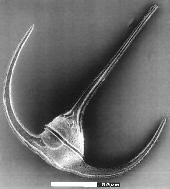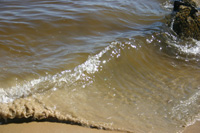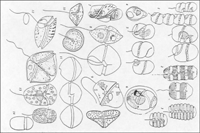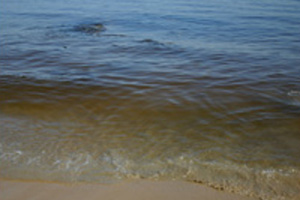- The brown-colored water seen in many areas of the Monterey Bay is due to a large dinoflagellate bloom.
- The three main dinoflagellates showing up are Cochlodinium catenatum, Gymnodinium sanguineum, and various species of Ceratium.
- This dinoflagellate bloom has not been linked to any human health problems.
- Dinoflagellates are microscopic, photosynthetic organisms that float freely in the open waters of the sanctuary.
During late August and into September of 2004, various areas of the Monterey Bay National Marine Sanctuary showed a brown tinge to the water. This coloring of the ocean water is due to a dense population of dinoflagellates, Cochlodinium catenatum, Gymnodinium sanguineum, and different species of Ceratium including Prorocentrum micans. The blooms of these dinoflagellates vary in composition depending on their location in the sanctuary.
Dinoflagellate blooms are thought to be triggered by seasonal fluctuations in nutrient levels in ocean water, but the cause of the current blooms of August and September of 2004 is unknown. So far these blooms have not been directly linked to human health problems.
Information obtained from Mary Silver of UC Santa Cruz and Greg Langlois of the California Department of Health Services.
More information:
- March 2005 article by Mary Silver on HABs – http://currents.ucsc.edu/04-05/03-07/algae.asp
- MBARI’s dinoflagellate webpage – http://www.mbari.org/staff/conn/botany/phytopl/phytoplankton_dinoflagellates.htm
- University of Calgary – http://www.geo.ucalgary.ca/~macrae/palynology/dinoflagellates/dinoflagellates.html



